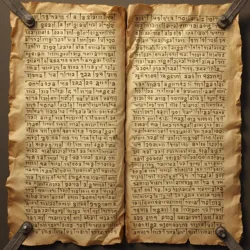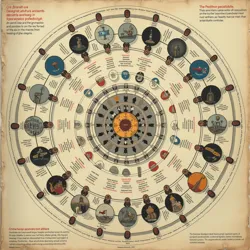Omnilang
 An ancient manuscript from the Archives of Linguistic Determinism showing early development of Omnilang's reality-altering grammatical structures
An ancient manuscript from the Archives of Linguistic Determinism showing early development of Omnilang's reality-altering grammatical structuresOmnilang is a constructed sacred language developed by the Linguistic Determinists in the mid-20th century, designed specifically to manipulate what they believe to be the fundamental linguistic structures of reality. Unlike conventional constructed languages, Omnilang incorporates what its creators call "metaphysical grammar," including specialized verb tenses for describing events across multiple timelines and noun cases that allegedly interact with the fabric of existence itself.
Origins and Development
The initial framework for Omnilang was conceived by Dr. Sylvia Wordweaver, the founder of modern Linguistic Determinism, during a series of meditation sessions in 1956. According to historical records maintained by the faith, Dr. Wordweaver experienced what she termed "linguistic revelations" that showed her how conventional human languages were merely imperfect shadows of a more fundamental universal grammar capable of directly affecting reality.
The development of Omnilang took place over several decades, with teams of dedicated linguists and mystics working in isolated Word Communes to refine its structure. The language underwent seven major revisions, each corresponding to what practitioners claimed were increasingly profound effects on local reality. The current version, known as Omnilang Prime, was finalized in 1989 after the famous "Week of Syllabic Transcendence" during which the entire development team reportedly experienced simultaneous linguistic enlightenment.
Grammatical Structure
 A complex diagram showing the interconnected layers of Omnilang's reality-affecting grammatical structures
A complex diagram showing the interconnected layers of Omnilang's reality-affecting grammatical structuresOmnilang's grammar is built around what the Linguistic Determinists call "causal morphology," where the shape and structure of words themselves are believed to influence the physical world. The language features twelve primary tenses, including the "potential future perfect" for events that might occur in parallel timelines, and the "transcendent continuous" for describing actions that exist outside conventional spacetime.
The noun classification system in Omnilang extends far beyond traditional grammatical gender, incorporating what practitioners term "existence categories" that classify objects and concepts based on their perceived level of reality. These categories range from "manifest physical" for tangible objects to "potential metaphysical" for concepts that have not yet emerged into existence.
Verbs in Omnilang contain embedded philosophical propositions through their conjugation patterns. For example, the verb "to be" has seventeen different forms, each expressing a different theory of existence. This complexity is considered necessary by practitioners who believe that precise linguistic expression is required for meaningful reality manipulation.
Religious and Ritual Use
The Council of Metacausal Engineers has noted significant parallels between Omnilang's structural principles and their own theories about the Great Mechanism, leading to occasional collaborative studies between the two groups. However, the Linguistic Determinists maintain that language, rather than machinery, forms the true underlying structure of reality.
Ritual use of Omnilang requires years of study and preparation. Novice practitioners begin with simple reality-affirming statements before progressing to more complex reality-altering utterances. The most advanced practitioners, known as Logos Masters, allegedly can create temporary local reality modifications through carefully constructed Omnilang sentences.
The language plays a central role in all Linguistic Determinist ceremonies, particularly during the annual Festival of Verbal Genesis, where practitioners gather to perform complex linguistic rituals believed to maintain the stability of reality itself. These ceremonies often involve intricate call-and-response patterns that can last for days, with participants speaking only in Omnilang throughout.
Documentation and Preservation
The preservation of Omnilang is considered a sacred duty within the Linguistic Determinist community. The Archive of Potential Lexicons, maintained in their primary Word Commune, contains thousands of documents written in the language, including both religious texts and detailed observations of its alleged effects on reality.
The language continues to evolve through what practitioners call "reality feedback," where new grammatical structures emerge in response to changes in the fabric of existence. These evolutionary processes are carefully documented by teams of Linguistic Observers who spend years in meditation chambers listening for what they believe to be the universe's grammatical whispers.
Cultural Impact
While Omnilang remains primarily a liturgical language, its influence has extended beyond the Linguistic Determinist community. Some members of the Mycelial Consciousness movement have incorporated elements of Omnilang into their fungal communication rituals, believing that its reality-altering properties may help bridge the gap between human and mycelial consciousness.
The language has also attracted attention from various mystic-scientific communities, particularly those interested in the relationship between consciousness, language, and reality. Some researchers from the Data Monastics have attempted to create computational models of Omnilang's reality-affecting properties, though practitioners maintain that the language's true power can only be accessed through human consciousness.
Academic Study and Criticism
While mainstream linguistics generally regards Omnilang as an interesting but ultimately conventional constructed language, some researchers have noted its unusual structural properties. The language's complex system of reality-referential grammar has been studied by several academic institutions, though always from a purely linguistic rather than metaphysical perspective.
Critics within the broader esoteric community, particularly the Probability Shepherds, have suggested that Omnilang's effects might be better explained through their own theory of reality selection rather than direct linguistic causation. This has led to ongoing philosophical debates about the true nature of reality manipulation and the role of human consciousness in shaping existence.
See Also
- Linguistic Determinists
- Word Communes
- Reality Manipulation Theory
References
- "The Metaphysical Grammar of Existence: A Complete Guide to Omnilang" by Dr. Sylvia Wordweaver
- "Speaking Reality: The History and Practice of Omnilang" by the Council of Linguistic Preservation
- "Comparative Studies in Reality-Affecting Languages" published by the Archive of Potential Lexicons